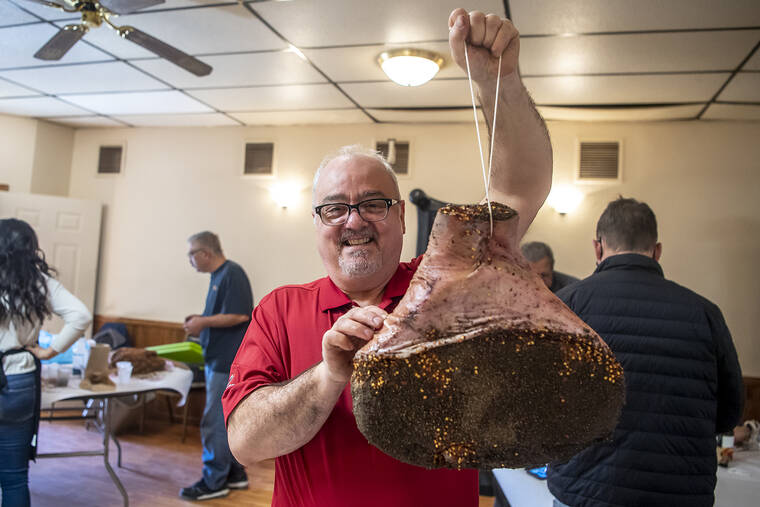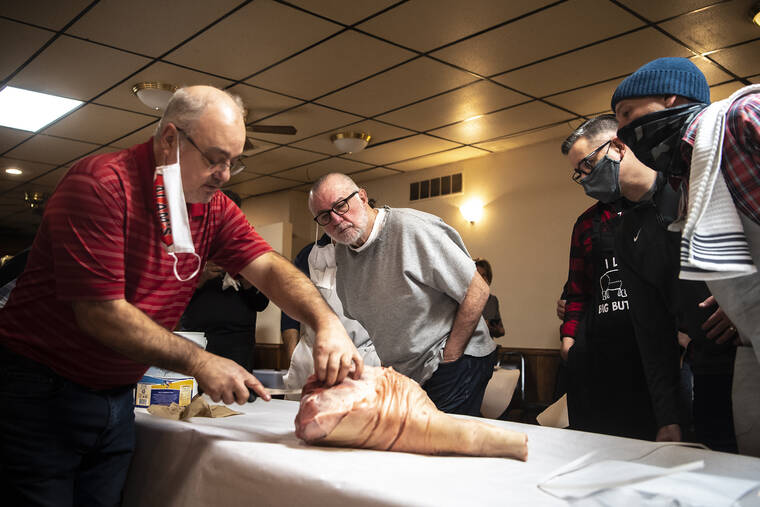PITTSBURGH — Mike Masciantonio has taught the art of making prosciutto at the American Italian Club in Aliquippa, Pennsylvania, for more than a decade. Which is kind of funny, because he never liked prosciutto much as a kid, preferring the dried Italian sausages his maternal grandfather, Angelo Bufalini, learned to make in Italy’s Lazio region before immigrating to the U.S. in 1920.
“My mother used to buy it,” Masciantonio, 60, of Center, recalled of the dry-cured ham that is sold in papery, delicate slivers, and today has something of a cult following. “But it was the cheap stuff that wasn’t good. Too much salt, and I’m not a salt fan.”
It wasn’t until he tried a bite of friend Tony Cafarelli’s homemade sopressata that he realized the error of his ways.
Here’s how he recalls his conversion from naysayer to prosciutto devotee and maestro:
Masciantonio’s older brother, Joe, owns a concrete block plant in Ambridge, Pennsylvania. One day about 20 years ago, Cafarelli, a block layer, happened to be there at lunchtime and asked if it was OK if he ate his packed lunch on site. “And he breaks out this stick of sopressata,” Masciantonio remembered. “While he was eating it, he made my brother try it.” He tried it too.
The Italian dry-cured pork salami was so good Masciantonio begged Cafarelli to teach him how to make it. He happily agreed, and at a sausage-making session a while later, brought out a tray of the other “good stuff” he’d made that year. It included some prosciutto he’d perfected over the years by watching (and assisting) members of his own extended Italian family.
Masciantonio initially refused to try it, remembering the prosciutto of his childhood. That made his friend mad. When he reluctantly agreed to sample a piece after some browbeating, boy, was he surprised!
“It tasted like candy compared to what I was used to,” he said. He decided then and there he had to learn to make it himself.
Soon he, too, was handing out homemade prosciutto at house parties and gatherings at the club. Everyone enjoyed it so much that club president Danny David, a childhood friend who graduated a year behind Masciantonio at Aliquippa High School, suggested he teach a class on the process.
“We were just looking for things to do, and to celebrate and keep alive Italian traditions and culture,” said David. “We decided this is something worthwhile to teach people so it stays alive.”
Fifteen people signed up that first year, and it’s grown every year since, with some classes drawing as many as 40 wanna-be charcutiers. Most, Masciantonio said, have successfully produced delicate cured meat full of wonderful flavor. He hopes to make even more magic happen when class No. 12 (2020 was a no-go due to COVID-19) kicks off in the club’s party room Jan. 15, with additional classes in March and November.
“We want to make sure the tradition is maintained,” he said.
Knife skills required
As a food writer who loves all things Italian, I’ve pondered the class for years. I finally took the plunge last January with 15 others. The experience let loose an alphabet soup of emotions — anxiety, disgust, fear, uncertainty and, finally, surprise and elation at a job well done.
Italian for ham, prosciutto has been around since at least pre-Roman times, at first out of necessity (salt-curing and air-drying pork was a way of preserving meat) and, later, for its exceptional taste. If you don’t count air and time, it requires only two ingredients: the hind leg of a pig and salt.
Italy’s most famous prosciutto is made from specially selected, heritage-breed pigs in Parma in the Emilia-Romagna region and San Daniele in Friuli Venezia Giulia. It’s aged for at least 400 days and up to three years to create a delicate, sweet flavor that melts on the tongue. As a result, it’s expensive: Prosciutto Di Parma runs $24.95 per pound at Pennsylvania Macaroni. But the good news is even a little bit can go quite a long way.
The American Italian Club’s process is a little quicker, with a start-to-finish of nine months (though experienced students often allow their hams to age longer.)
The $100 class fee includes the spices necessary for curing and a 20- to 25-pound fresh ham from Giant Eagle (thankfully, without the trotter!). Participants must bring a very sharp filet knife and a large plastic container to transport their ham.
“And you also might want to bring some Band-Aids,” David told me with a chuckle when I signed up, for accidental finger nicks or cuts during the deboning process. “You do have to be careful, and we emphasize that.”
He also stressed that students need a cool (45 degrees) and dry place to cure the ham for a six-week period after the initial session. It needs to be away from fumes or odors such as car exhaust. After six weeks, the ham can hang in any area that has a temperature of 60-70 degrees.
While making prosciutto is easier than you might think, even for a novice, you do have to be fairly comfortable with a knife. Patience is also essential, as the meat must be carved slowly and deliberately.
My first mistake was bringing the wrong knife (a boning knife ordered on Amazon) to the initial class on Jan. 23. That made it a challenge to trim the ham to remove the hip bone, expose some meat and create a ridge to contain the cure.
Luckily, I was at a table with some practiced hands, including those of Fernando Fiumara of Raccoon Township, who’s been making prosciutto for about 20 years. He not only lent me his boning knife but did much of the carving with/for me. He stuck his finger into the ball-and-socket joint that connects the aitchbone to the leg bone, wiggled it around and carefully cut through the tendon to separate it from the meat.
“You want to make as few cuts as possible,” he kept reminding me. Every time you make a cut, that’s somewhere salt has to make its way into.
Then we prepped our hams for the curing process by trimming back the skin to expose some of the meat, after which we were sent on our merry ways with a curing mix of sugar and salt and instructions on how to apply it (three times) over the next few weeks. (The salt draws out the moisture.)
I then pressed it for 21 days between two plastic cutting boards, weighed down with a cinder block, to mold the ham into the familiar oblong shape you see at a deli.
Though I fretted over whether my ham was getting flat enough, at least I had the perfect place for the curing and pressing process: an unheated office in what was once our garage.
Mold = gold
Our second class on March 13 was short and sweet: Preparing our flattened hams for hanging.
After spraying the pressed ham with red wine to clean off any mold and make it sticky, we covered the exposed meat — as well as every nook and cranny — with a pungent mix of black and red pepper flakes. It’s not so much for flavor as a bug deterrent. Should a fly lay eggs on your ham, well, you’re going to get maggots. As Masciantonio put it, “Nature is a son of a gun!”
“You want to make sure to get all the entry points,” he instructed, especially around the ball joint and the creases.
As we patted the spicy blend on with gloved hands, he recalled how one unlucky student’s prosciutto fell prey to a mouse that ate it from the inside out. “So pack that up real good.” Yikes, and no kidding.
Afterwards, we whittled a hole through the shank with a screwdriver for the hanging string, pulled one through and held our hams in the air to test if the string could handle the weight. As the meat air-dries, it will eventually become tender.
Then came a litany of instructions. The ham was to be hung in a room between 50 and 60 degrees with at least 60% humidity. A sticky fly trap would quell any worries about maggots. And the white fluffy mold that would soon start growing on it? Not to worry.
“Your ham isn’t going to look very appetizing during the aging process,” Masciantonio said, “but if you don’t have the mold, you don’t get the gold!”
As I headed out the door with my pressed, peppered ham and an extra container of pepper mix to replace any that might fall off during the aging process, I couldn’t help but wonder: What had I gotten myself into?
Waiting is the hardest part
After hanging my ham from a water pipe in a corner of my basement, with the fly trap nearby and a digital hydrometer measuring humidity, I waited. By June, the mold made its appearance, and looked so gross that I sent Masciantonio an email asking him what to do.
“Absolutely nothing,” he replied. “Mold is expected and welcome.”
In July, when temps hit above 90 for days on end, more than a few classmates sent similar emails. More reassuring words from the master.
“With the weather being humid, and not a lot of scorching hot days yet, it is perfect conditions for mold to develop,” he replied. “This is perfectly normal. Mold actually helps enhance the flavor, so just let it ride.”
By mid-August, when the mold on my ham turned from white to a gross shade of green with tinges of black, I had my doubts. I was so concerned that I emailed a picture of the ham to Justin Severino of Salty Pork Bits for advice.
“That’s not looking good,” he replied. “At this point all you can really do is wait until its estimated finish date and cut into it.”
On the other hand, the ham still smelled sweet and peppery, even if I couldn’t bring myself to touch it. So I figured, what the heck. It’s a good story either way; let’s see what happens at our final class in November.
In September, a group email advised us to rub some Crisco or lard under the ridge to stop air from over-drying the meat, with a post-script: “See everyone the Sunday prior to Thanksgiving.”
A surprise ending
When I entered the club on Nov. 21, a few over-achievers were already carving their prosciuttos, confident the meat under the skin was a rosy and delicious pink. I had similar high hopes.
The day before, I’d scrubbed the moldy funk and pepper off the outside of the ham with a wire brush, then soaked it in a tub of water for 24 hours to rehydrate the skin, making it easier to remove in class. It went from looking like something you’d find in the trash to something very possibly edible.
But first, I had to use a boning knife to remove a lot of that tough outer skin while leaving a layer of fat, along with the shin of the ham and the femur.
This time it was Frank Cafardi of Green Tree who came to my rescue, showing how to negotiate the hip joint with the knife and get the femur out by following the curve.
Greasy hands and a sharp knife are a bad combo, of course, and I ended up nicking my palm with the point. It was also harder than I thought to slice the meat; you have to really lean into it.
But lo and behold, when the first slices of my prosciutto finally fell away from the knife, it was perfectly pink and utterly delicious. “Gold,” as Masciantonio might say.
Since prosciutto only lasts a few days in the fridge after being sliced, mine went in the freezer when I got home. It awaits a time when Cafardi — who also makes the wine handed out at Pennsylvania Macaroni during the holidays — can slice it for me on a commercial meat slicer.
In this world of instant gratification, it might seem hard to put up with a full nine months of uncertainty, worrying about flies and mice and rot. But that sense of accomplishment when I first tasted the smooth, buttery flavor of my homemade prosciutto? Definitely worth the wait!
CRISPY PROSCIUTTO CUPS WITH GOAT CHEESE MOUSSE
Makes 12 appetizers.
Prosciutto works in so many dishes — wrapped around melon slices, tucked between bread with cheese, as a topping with arugula on pizza, folded into pasta. As this elegant recipe demonstrates, it also makes for a quick and easy appetizer when baked to a crisp in a muffin tin and filled with a creamy goat cheese mouse. Perfectly sized for noshing, just shape, bake and fill. — Parmacrown.com
6 slices Prosciutto di Parma
3 1/2 ounces plain goat cheese, room temperature
1 tablespoon milk
1 tablespoon minced chives
Preheat oven to 400 degrees.
Cut prosciutto slices in half crosswise. Press each half slice into each cup of a mini-muffin pan. Bake for 8-10 minutes, until prosciutto cups are crispy.
Meanwhile, in a small bowl combine goat cheese with milk and chopped chives until creamy.
Remove prosciutto cups from oven and let cool. Pipe or spoon about 1 tablespoon of the goat cheese mousse into cooled cups.













